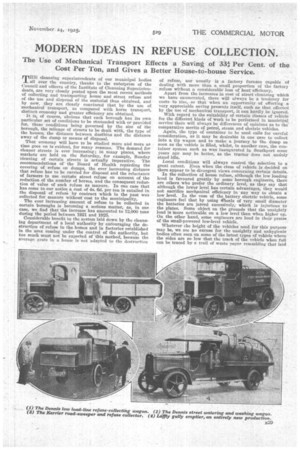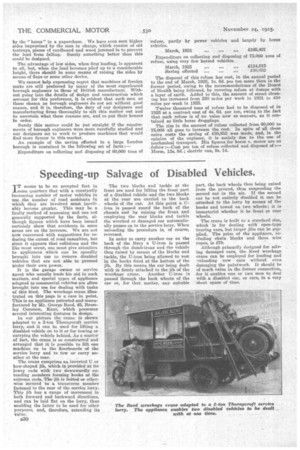MODERN IDEAS IN REFUSE COLLECTION.
Page 13

Page 14

If you've noticed an error in this article please click here to report it so we can fix it.
The Use of Mechanical Transport Effects a Saving of 33:11Per Cent. of the Cost Per Ton, and Gives a Better House-to-house Service.
TBE cleansing superintendents of our municipal bodies all over the country, thanks to the enterprise of the Council and officers of the Institute of Cleansing Superintendents, are very closely pasted upon the most recent methods of collecting and transporting house and street refuse and of the use and disposal of the material thus obtained, and by now, they are clearly convinced that by the use of mechanical transport, as compared with horse transport, distinct economy and greater efficiency are obtained.
• It is, of course, obvious that each borough has its own particular set of conditions to be contended with or provided for, these conditions being governed by the size of the borough, the mileage of streets to be dealt with, the type of the houses, the distance between dustbins and the distance away of the dump or means of disposal.
That economy will have to be studied more and more as time goes on is evident, for many reasons. The demand for• cleaner streets is ever increasing; in many places, where markets are held on the Saturday, for example, Sunday cleaning of certain streets is actually imperative. The recommendations of the Board of Health regarding the covering of refuse on dumps, the ever increasing distance that refuse has to be carried for disposal and the reluctance of farmers to use certain street refuse on account of the reduction of the number of horses, and the consequent reduction of value of such refuse as manure. In one case that has come to our notice a cost of 4s. 6d. per ton is entailed• in the disposal of refuse by contract which in the past was collected for manure without cost to the municipality.
The ever increasing amount of refuse to be collected in certain boroughs is becoming a serious matter, as, in one ease, we find that the increase has amounted to 12,000 tons during the period between 1921 and 1925. •
Considerable benefit to the system laid down by the cleansing department of a local authority by encouraging the destruction of refuse in the homes and in factories established in the 'area coming under the control of the authority, but too much must not be expected of this method, because the average. grate in a house is not adapted to the destruction of refuse, nor usually is a factory furnace capable of dealing with more than a small proportion of the factory refuse without a considerable' loss of heatefficiency.
Apart from the increases in cost of street cleansing which we have enumerated, there will always be a tendency for costs to rise, so that when an opportunity of effecting a very appreciable saving presents itself, such as. that effected by the use of mechanical transport, it can hardly be ignored.
With regard to the suitability of certain classes of vehicle for the different kinds of work to be performed in municipal service there will always be differences of opinions as to the comparative merits of petrol, steam and electric vehicles.
Again, the type of container to be used calls for careful consideration, as it may be desirable in one case to collect into a tip wagon and to make a journey to the dump so soon as the vehicle is filled, whilst, in another case, the container system such as was inaugurated in Southport some years ago may be better, as the tractor does not unduly stand idle.
Local conditions will always control the selection to a great extent. Even when the class of vehicle is decided on there appear to be divergent views concerning certain details.
In the collection of house refuse, although the low loading level is favoured greatly by some borough engineers, there are others who prefer the ordinary level, as they say that although the lower level has certain advantages, they would not sacrifice mechanical efficiency in any way to obtain a low level. In the case of the battery electric vehicle, some engineers feel that by using Scheels of very small diameter the batteries are jarred excessively,which is injurious to the plates. Some object on the grounds that the unsightly load is more noticeable on a low level than when higher up. On the other hand, some engineers are loud in their praise of the small-powered low-level vehicle.
Whatever the height of the vehicles used for this purpose may be, we see no excuse for the unsightly and unhygienic bodies often seen on some of the latest types of vehicle where the sides are so low that the track of the vehicle when full can be traced by a trail of waste paper resembling that laid by the "hares" in a paperchase. We have even seen higher sides improvised by the men in charge, which consist of old teatrays, pieces of cardboard and wood jammed in to prevent the load from falling. Surely something better than this could be designed.
The advantage of low sides, when first loading, is apparent to all, but, when the load becomes piled up to a considerable height, there should be some means of raising the sides by means of flaps or some other device.
We cannot help expressing regret that machines of foreign make are still preferred by many of the most experienced borough engineers to those of British manufacture. Without going into the details of design and construction which account for this preference, it is evident that such men as those chosen as borough engineers do not act without good reason, and it is, therefore, the duty of our designers and manufacturing firms thoroughly to sift this matter out and to ascertain what these reasons are, and to put their houses in order.
Surely this matter could be put straight if the requirements of borough engineers were more earefully studied and our designers set to work to produce machines that would find more favour in this market.
An example of the saving effected in a large London borough is contained in the following set of facts :— Expenditure on collecting and disposing of 60,000 tons of
refuse, partly by power vehicles and largely by horse vehicles.
March, 1921 ... £165,427 Expenditure on collecting and disposing of 75,000 tons of refuse, using very few horsed vehicles.
March, 1925 £134,575 Saving effected ±30,852 The disposal of this refuse has cost, in the annual period to the end of March, 1925, 1s. 6d. per ton more than in the former period, owing to the recommendations of the Board of Health being followed, by covering refuse at dumps with a layer of earth. Added to this, the amount of street cleaning has increased from 320 miles per week in 1921 to 450 miles per week in 1925. Twelve thousand tons of refuse had to be disposed of in 1925 at a contract cost of 4s. 6d. per ton, owing to the fact that such refuse is of no value now as manure, as it contained so little horse droppings.
The rise in the amount of refuse collected from 60,000 to 75,000 all goes to increase the cost. In spite of all these extra costs the saving of £30,852 was made, and, in the opinion of the engineer, it is mainly due to the use of mechanical transport. His figures for horse v. motor are as follow :e--Cost per ton of refuse collected and disposed of :— Horse, 13s. 8d.; electric van, 9s. id.




































